Betta’s are more than just beautiful aquarium pets. They are also known for their unique and often quirky personalities. How can you tell the difference between a healthy Betta laying on its side, and a sick Betta laying at the bottom of the tank? Learn to spot odd-but-normal Betta behavior from a troubled tank in this short guide!
Why Is Your Betta Laying On The Bottom Of The Tank?

Betta’s (Betta splendens) display a variety of interesting behaviors and have distinct personalities that make them a great option for first-time fish keepers. But their quirky personalities come with a downside; many Betta’s enjoy floating, swimming or laying in strange positions in their tanks.
It can be difficult for novice aquarists to tell the difference between their Betta’s weird-but-normal behavior from the signs that they are getting sick and need help. What are the Top 5 reasons to see betta fish laying sideways in their tanks?
1. Sleeping
If you’ve ever wondered if fish can sleep in the water, the answer is a definite yes. Bettas are diurnal and are most active during the daylight hours. When the lights go off, your fish will relax and get some well-deserved rest. Some bettas prefer to float while they sleep, while others may rest on your decor or substrate.
If you spot a betta fish laying on their side at night there’s no reason to panic! Most likely you’ve caught them during a nap. If your fish swims normally during the day and doesn’t show other signs of illness (see the list below) then this is probably just their unique way of sleeping underwater.
2. Lazy
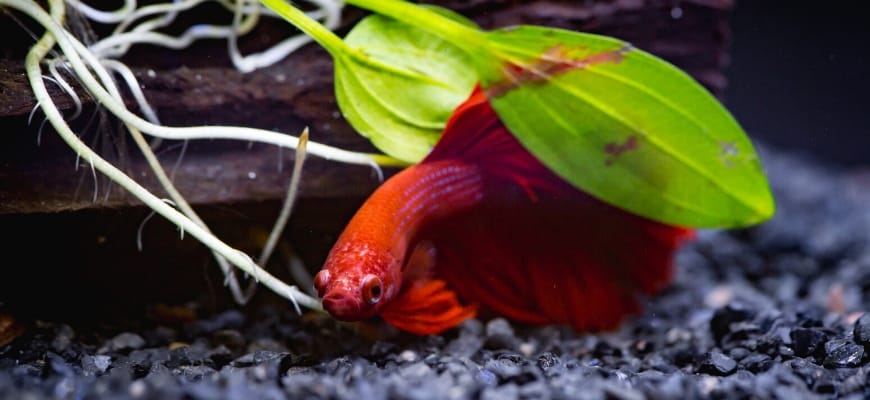
What if you see your fish on the bottom of the tank during the day? Does that mean there is a problem? Not necessarily. Some betta fish are lazy. I had a betta who preferred to tangle herself in live plants and float sideways for a few hours a day. Another flashy male betta would spend his afternoons propped up on a log.
As with sleeping bettas, a lazy betta should still have a good appetite and be able to swim normally when they want to. But lazy bettas are also prone to obesity, so be sure you’re not overfeeding them. If the behavior starts suddenly, keep an eye out for further signs of trouble, and be proactive and do a water change to be safe.
3. Bored Or Depressed
Bettas are curious fish who constantly interact with their environment. In the wild, this exploratory behavior is how they find food. Bettas don’t enjoy a bare tank and can get very bored and depressed if they don’t have plants and decor to play with. A bored betta may also pick at their fins or rub against their substrate as well.
4. Advanced Age
Like all animals, it’s normal for fish to be less active as they get older. Aquarium bettas usually survive between 2 and 5 years, and as they age you can expect them to spend less time exploring their tank and playing with toys. Many older betta fish also begin to lose their sight, which reduces their activity as well.
5. Developing Health Problems
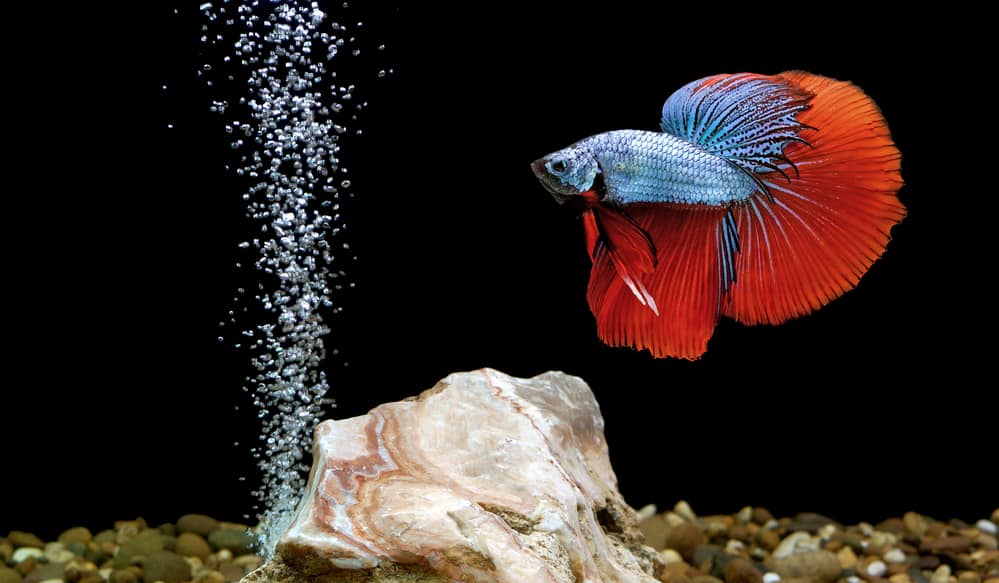
While it’s not unusual for healthy bettas to lay around their tank because they are sleeping, acting lazy, or bored, you should be concerned if they are showing or start developing further signs of illness. Oftentimes, you’ll notice your betta is stressed and a bit off for a few days before clearer symptoms present themselves.
Symptoms Of A Stressed Or Sick Betta Fish
The most common signs that your betta isn’t feeling well or is stressed includes:
- Unusual lethargy, disinterest in playing and exploring, or hiding.
- Decrease in appetite or refusal to eat (for several days).
- Faded or muted colors, especially in the usually bright and vivid male fish.
- Picking at their fins or rubbing their bodies and fins on your aquatic decor or substrate.
- Inability to stay upright or swim normally.
- Labored breathing.
- Clamped fins held closely to the body.
- Damaged fins or scales.
If you see any of these symptoms, you should examine your betta and aquarium set-up closely and test your water quality. Once you know whether you’re having a disease outbreak or a problem with your tank or water parameters, you’ll be better able to start tackling the issue and save your fish.
How To Diagnose A Sick Betta: Common Aquatic Diseases And Disorders
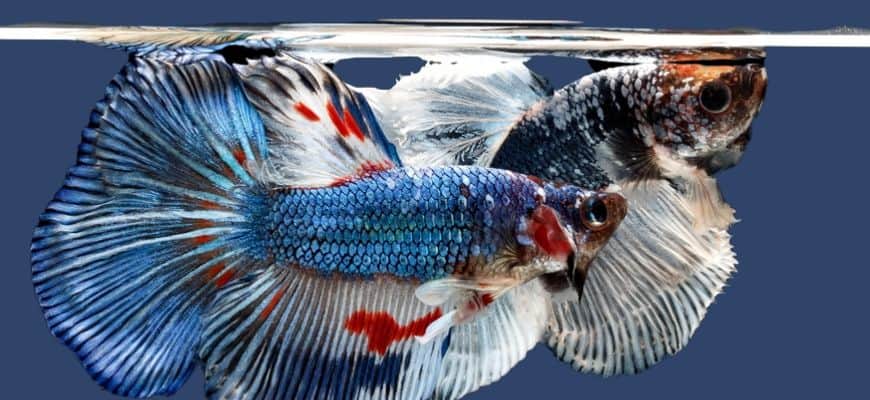
Bettas are prone to developing several aquatic illnesses. Some disorders are related to their genetics and can be influenced by factors such as their diet and feeding regimen. Other diseases are usually linked to poor water quality and the opportunistic pathogens already in your tank. Betta diseases and disorders include:
Tail And Fin Rot
Fin and tail rot is one of the most common Betta health problems to run into, especially if you opt to keep the fanciest types of male bettas. Good maintenance routines and regular water changes are the best way to prevent an outbreak from occurring in your tank. Many older bettas develop a chronic version of this disease.
- Female fish and short-tailed types of males rarely seem to develop fin rot.
- Fin rot can be influenced by many factors, but is usually related to poor water quality and shows up in fish that are highly stressed.
- While fin rot is caused by bacteria, viruses or fungi already present in your water, healthy fish rarely develop symptoms until they reach an advanced age unless there is another trigger (like missed water changes).
Fin Rot Symptoms And Treatment
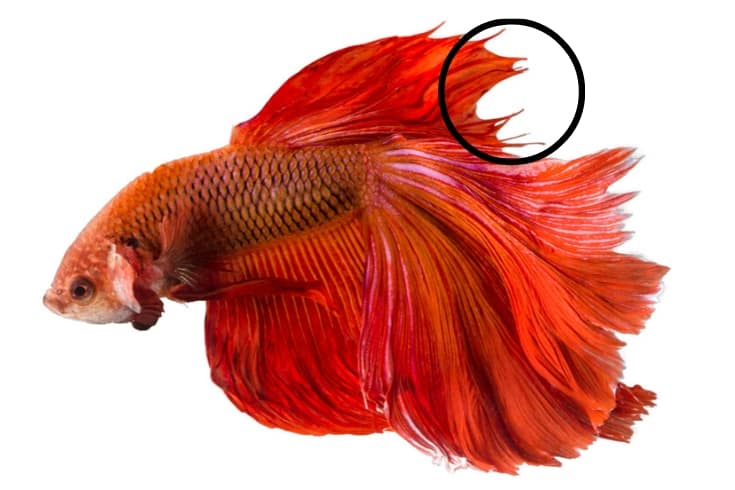
There are several stages of fin rot in bettas. At first, your fish may be lethargic, not eating well and may rub against their aquarium decor. The first clear signs show up as ragged red or black edges along the fins. As symptoms progress, the fins begin to melt away and the rot progresses towards the body, which may lead to death.
Your betta may lose the ability to swim and end up laying on their decor or substrate, but that usually doesn’t happen until the disease is well progressed.
- If caught early, fin rot can often be halted, although damaged fins may not grow back normally.
- Aquarium salts are useful for halting progression in early and moderate cases.
- Medications like Maracyn 2 and/or API Fungus Cure may be needed for advanced cases that don’t respond to salts or other changes in your tank management.
Swim Bladder Disorder
If your betta fish is swimming on their side or can’t stay upright no matter how hard they try, they may have a problem with their swim bladder.
- These small organs allow your betta to maintain their buoyancy and orientation in the water.
- Since swim bladders are located behind the other internal organs, a full stomach or intestine can push on or deflate them, causing instability while swimming.
Young bettas often have temporary problems with the swim bladders as they grow but this usually resolves on its own. Overweight bettas or those fed too many treat foods may develop chronic constipation that eventually permanently damages their swim bladder and affects their ability to dive and swim in a straight line.
Swim Bladder Disorder Symptoms And Treatment
A fish with swim bladder problems can’t swim upright or orient themselves in the water. They may tip to one side as they float, or you may find your betta laying upside down on the bottom of your tank. Swim bladder disorders are fairly common in adult bettas and may be genetically based, but the main risk factor is an overweight fish.
Fish can often live for years with swim bladder disorder as long as they can feed themselves and don’t have other health problems. We can’t always identify the cause and many cases are not curable, unfortunately. Here’s the best way to treat swim bladder problems in an overweight or constipated betta:
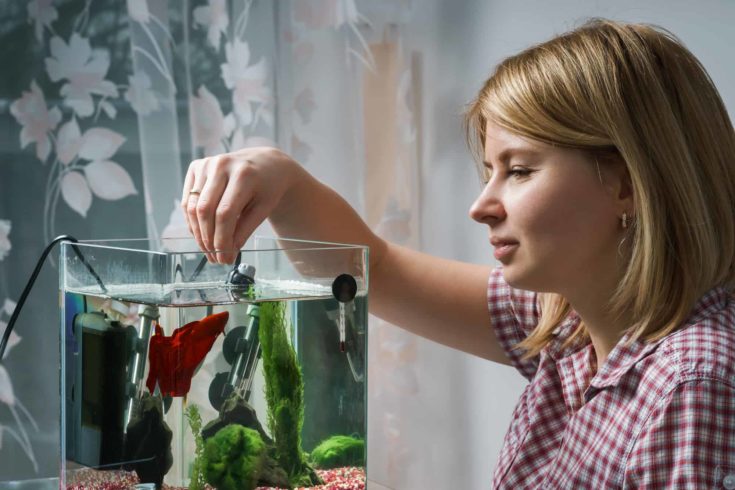
- Try fasting your fish for a couple of days.
- After fasting, offer a small amount (a portion the size of their eyeball) of a high-quality commercial floating betta diet once a day.
- If you’ve been feeding high-protein treats, reduce the number of treats offered to no more than 1 or 2 meals a week.
- You should see improvement in their swimming within a few days is it’s related to constipation, or a few weeks if it’s related to their weight.
White Spot Disease (Ich)
A common problem in bettas and other freshwater aquarium fish is the one known as White Spot Disease aka Ich. It’s caused by parasitic protozoans that are nearly always present in your aquarium water. Fish rarely develop symptoms unless they are stressed for other reasons, however. Everyone faces an Ich outbreak eventually.
Ich Symptoms And Treatment
The first signs of trouble are usually small white dots that seem to appear overnight on your betta’s head, gills or gill covers, body and/or fins. As it progresses, the spots cover more of their body and your betta gets sicker. They may eventually develop ulcerations on their bodies from secondary infections.
It’s best to prevent Ich outbreaks by quarantining new fish or plants in a hospital tank for 7 to 14 days before introducing them to your main tank, and by keeping your tank’s parameters stable with a good filtration system and heater. As soon as you notice a sick fish it’s best to start treating the entire tank:
- Use aquarium salts to raise the salinity of your water (it also soothes your fish’s skin).
- Gradually raise your aquarium’s temperature to speed-up the parasite’s life cycle (82 to 86°F).
- Change up to ½ the water in the tank daily, vacuuming the gravel well to remove as many encapsulated parasites as possible.
- If these steps don’t help, you may need to use medications like copper sulfate or malachite green.
Velvet
A less common disease caused by photosynthetic water parasites is known as Velvet or Rust. Velvet is most likely to break out in tanks with poor water quality and low temperatures. If you keep up on your regular water changes and maintain stable temperatures, it’s unlikely your Betta will get stressed enough to get sick with Velvet.
Velvet Symptoms And Treatment
Velvet looks like a coating of rust or gold dust on the surface of your betta. They are usually covered in specks from head to tail. It’s a very itchy disease, and your fish will rub against their decor and substrate right before they show clear symptoms. The parasite is light sensitive, so the best way to treat Velvet is to take 3 steps:
- Use aquarium salts to increase the salinity of your water.
- Gradually increase the temperature to over 80°F (82 to 85°F is ideal).
- Remove your light fixture and prevent any light from entering the tank while treating your fish (helps “starve” the parasite).
Popeye
If you’ve ever seen a betta with popeye you’ll understand where it got its name. This disorder causes a fish’s eyes to bulge out of their faces. It’s usually caused by injury or environmental factors, such as an extended amount of time in very dirty water, but some fish with tuberculosis also develop popeye.
The treatment varies depending on whether your fish is injured or sick. If just one eye is popped out, it’s probably an injury from your decor, but if it’s both eyes it could be a bacterial infection. You should remove your fish to a hospital tank and treat with ampicillin and aquarium salt. Many cases of popeye are not curable, however.
Dropsy
If your betta is swollen and resembles a pine cone, then they probably have a disorder known as dropsy. Dropsy can be triggered by a wide variety of bacterial, viral and even fungal and parasitic infections. It’s a secondary problem that crops up in fish that have been sick for a while, and is often fatal.
While you should quarantine a betta with dropsy and treat with broad-spectrum medications like Maracyn 2, there’s a good chance that your fish won’t survive. The medications are very stressful, and often a fish is beyond saving by the time you catch it. It’s easier to prevent Dropsy with good aquatic maintenance than to treat.
Other Infection(s)
Bettas may also be exposed to other pathogens in your water or from tank mates or plants that have been introduced without a quarantine period. You may see patches of a cotton-like fungus on your fish, or they may develop secondary infections from bacteria or viruses.
The proper treatments will just depend on the problem, and you may need to take some pictures or bring your fish to an aquatic store or vet for a diagnosis. Overall, though, most fish diseases can be avoided entirely through good husbandry, regular water changes and properly maintained equipment.
Fish Feeder Style
Rotating Barrel Feeder
Ideal for extended trips, feeding medium to large populations, and both aquarium and pond communities
Pros
Large holding capacity
Flexible programming allows for multiple meals and portion sizes
Wide variety of models and brands available
Cons
Can only dispense one type of food at a time
Works with a limited number of diets
Performance is usually better with pellets vs flakes
Can’t accurately dispense very small portions
Require regular maintenance
Fish Feeder Style
Portion Control Feeder
Ideal for short trips, diverse communities that need multiple types of food and tanks with small populations
Pros
Works with most types of commercial diets
Can dispense multiple types of food per meal
Very precise and can easily dispense small portions
Cons
Capacity is limited by the number and size of the meal slots
Programming options are a lot more limited
Requires more work to measure food and hand-fill meal slots
Only a few brands and models available
How To Identify Problems With Your Betta’s Aquarium
Pathogens are not the only reason your betta fish may act strangely. What should you do if your betta is acting odd but doesn’t seem to be sick with an obvious illness or disorder? Look over your calendar and see if you’ve kept to your schedule for water changes or if you’re due for one.
Nitrate Poisoning

While aquatic bacteria do a good job of breaking toxic ammonia into safer nitrates, these nitrates can still poison your fish and lead to nitrate shock and death if the water isn’t changed often enough. Some fish start showing signs of stress when the nitrate rises to only 20 ppm/L (parts per million/liter).
If your betta is laying on the bottom of the tank gasping, like they can’t breathe, they could be developing nitrate poisoning or starting to go into shock. You’ll need to do an immediate water change to save your fish. Other signs include:
- Lack of appetite.
- Rapid respiration with a lot of gill movement.
- Acting lethargic, listless or confused.
- Curling up with their head and tail tucked into a ball (advanced case).
High Ammonia Levels
If you’re just starting a brand new betta tank, you could run into a problem with high ammonia levels. Before your aquatic bacteria become established, it’s normal to have spikes of ammonia as your nitrogen cycle balances itself. It’s why we usually recommend waiting until the cycle is complete before adding fish to a new tank.

If you suspect your ammonia levels are high, you should test the water, perform a water change and use an ammonia-absorbing media in your filtration system. If you catch this problem quickly, your fish may recover, but long term exposure will reduce their lifespan. Signs that your betta is suffering from high ammonia levels include:
- Weakness and laying at the bottom of the tank.
- Red, purple or bleeding gills.
- Clamped fins and a darker than usual coloration in their scales.
Current/Filtration Outflow Is Too Strong
Betta fish do not like to swim in currents or filtration outflows and will actively avoid areas in your tank with too much movement. If your filtration outflow is causing your fish to hide on the bottom of the tank, you can fix the problem by using a baffle. Baffles can divert the water and break-up the current, allowing your betta to swim in peace.
Water Temperature Is Too High Or Too Low
The ideal temperature for a betta tank is between 75-86°F, but some fish may prefer warmer or cooler temps in that range. If your fish is lethargic or hiding on the bottom and your tank is at the low end of the spectrum, try raising the temp a bit. But don’t make it too high! Bettas also stop moving around when they get too hot as well.
Aquarium Is Small Or Cramped
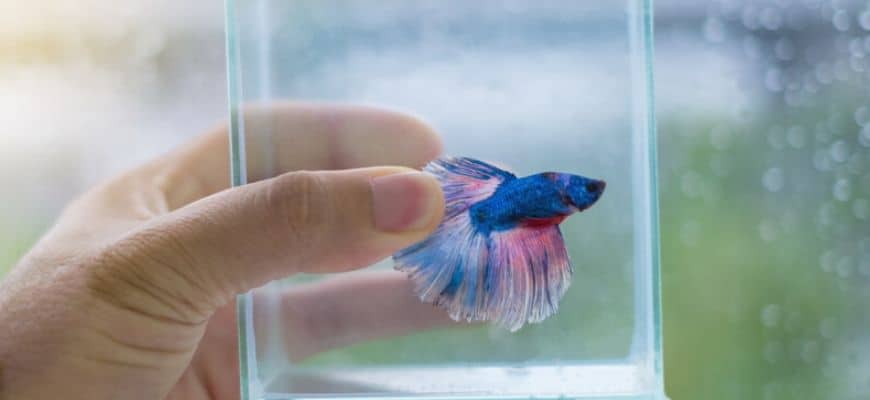
I know there’s this myth that bettas can survive in very small ½-gallon fish bowls. The truth is, such small environments cause a great deal of stress. Bettas prefer to have at least a 5-gallon tank to themselves, and if you’ve added tank mates, toys, and decor for stimulation, they may need a bigger aquarium.
Conclusion
It can be scary to discover betta fish floating upside down, but it doesn’t always mean there’s a problem with your fish. Sometimes bettas are just a bit quirky. There are times this behavior signals a bigger problem, so it never hurts to look your tank over and test the water chemistry. Tell us about your betta’s quirky habits in the comments!

great information i wish i had found this site earlier . i recently lost my betta , was not sure why . i had him for 2years in a 3gallon half oval tank. i found what looks like fin rot on the end of his fin. i looking to buy another betta soon. will use this site often . thank you .
Thanks for the useful sharing. My bettas are standing still and sometimes just swimming sideways. It’s probably bladder disease.